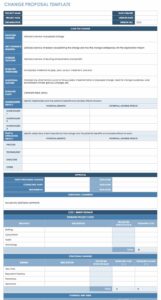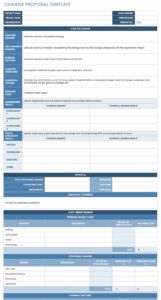Maintaining such a record offers several advantages. It minimizes confusion and disputes by providing a clear audit trail of all modifications. This, in turn, improves communication among stakeholders, streamlines decision-making related to changes, and helps maintain project control. Ultimately, a well-maintained record contributes to successful project delivery by enabling efficient management of evolving requirements.
The following sections will delve into the key components of this type of documentation, best practices for its utilization, and the various tools and techniques available for effective implementation.
Key Components
Effective management of project modifications requires a structured approach to documenting change requests. Several key components ensure comprehensive recording and tracking of proposed alterations.
1. Change Request Identifier: A unique number assigned to each request allows for easy identification and tracking. This ensures clear referencing throughout the project lifecycle.
2. Request Date: Recording the submission date provides a chronological record of changes, aiding in historical analysis and reporting.
3. Requester: Identifying the individual or group initiating the change clarifies responsibility and facilitates communication.
4. Description of Change: A concise and unambiguous explanation of the proposed modification ensures all stakeholders understand the nature of the request.
5. Justification: The rationale behind the change request provides context for evaluation and decision-making.
6. Impact Assessment: Analysis of potential effects on project scope, schedule, budget, and resources informs decision-makers about potential consequences.
7. Approval Status: Tracking the approval process (pending, approved, rejected) provides transparency and control.
8. Implementation Status: Documenting the progress of implementation (planned, in progress, completed) ensures effective follow-up and closure.
These components provide a framework for capturing essential information related to project changes, promoting informed decisions, and fostering successful project outcomes.
How to Create a Change Request Log
Creating a standardized document for tracking modifications is crucial for effective project management. The following steps outline the process for establishing a robust system.
1. Define Required Fields: Begin by identifying the essential information needed to capture each change request. This typically includes a unique identifier, request date, requester, description of change, justification, impact assessment, approval status, and implementation status. Tailor fields to specific project needs.
2. Choose a Format: Select a suitable format, such as a spreadsheet, database, or dedicated project management software. Consider factors like accessibility, collaboration features, and reporting capabilities.
3. Establish a Consistent Naming Convention: Use a clear and consistent naming convention for the document and its versions to facilitate easy retrieval and prevent confusion.
4. Set Access Permissions: Define user roles and permissions to ensure appropriate access and control over the document. This maintains data integrity and prevents unauthorized modifications.
5. Train Project Team Members: Provide training on the purpose, usage, and importance of the log. Ensure all team members understand how to submit, track, and update change requests.
6. Integrate with Project Management Processes: Incorporate the change management process into existing project workflows. Establish clear procedures for submitting, reviewing, and approving change requests.
7. Regularly Review and Update: Periodically review the log to ensure accuracy and completeness. Update fields and procedures as needed to reflect evolving project requirements.
A well-defined process, combined with a user-friendly format and comprehensive training, ensures consistent and efficient management of project modifications, contributing to project success.
Effective management of change is critical to project success. A standardized change request log provides a structured mechanism for documenting, tracking, and controlling modifications throughout the project lifecycle. Key components such as unique identifiers, clear descriptions, justifications, and impact assessments facilitate informed decision-making. Utilizing a consistent format, establishing clear procedures, and providing adequate training are essential for successful implementation. Regular review and adaptation ensure the log remains a valuable tool for managing evolving project requirements.
Organizations that prioritize robust change management practices enhance project transparency, improve communication, and minimize potential disruptions. Investing in comprehensive change management tools and processes ultimately strengthens project outcomes and contributes to organizational success.

